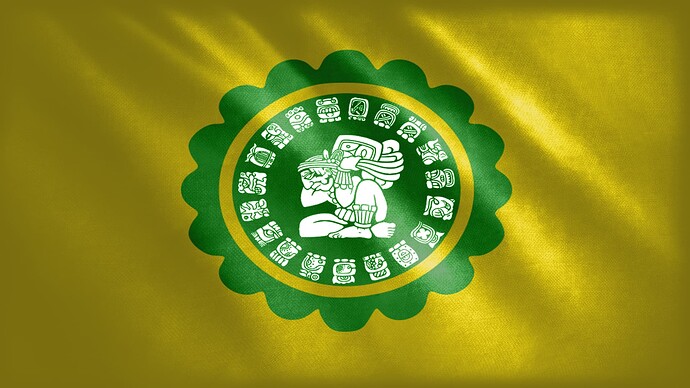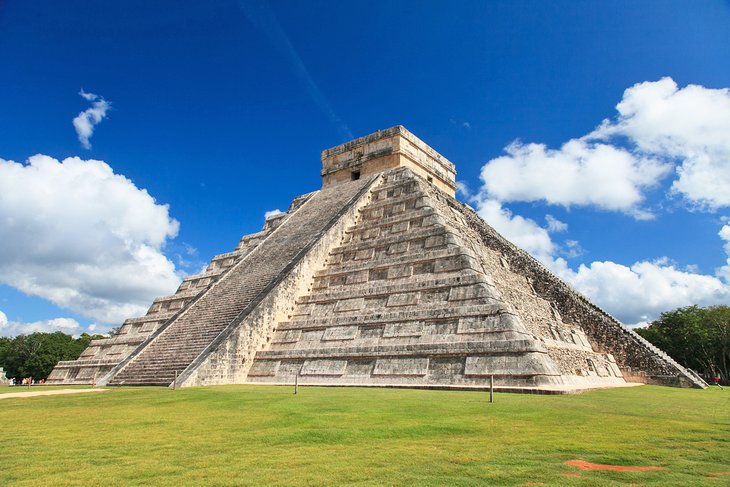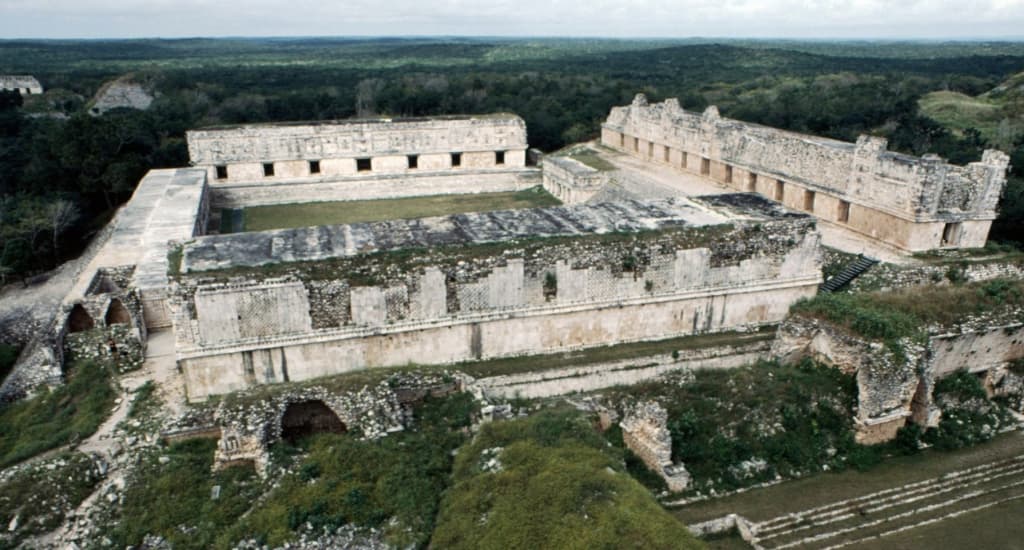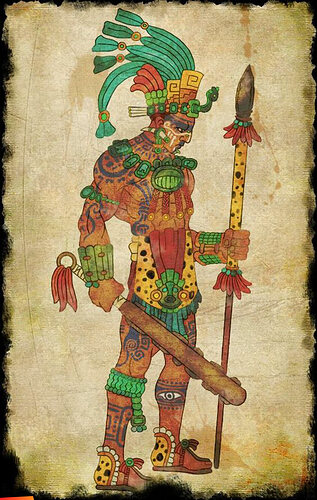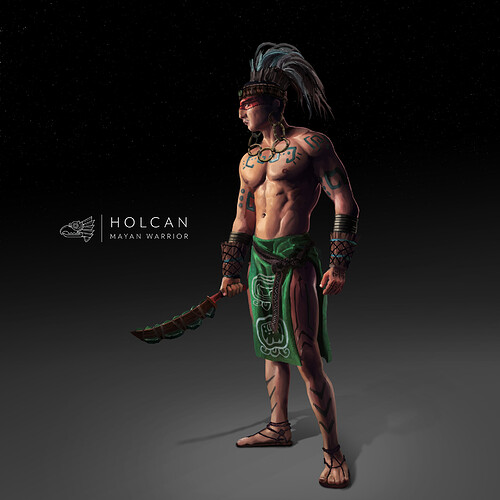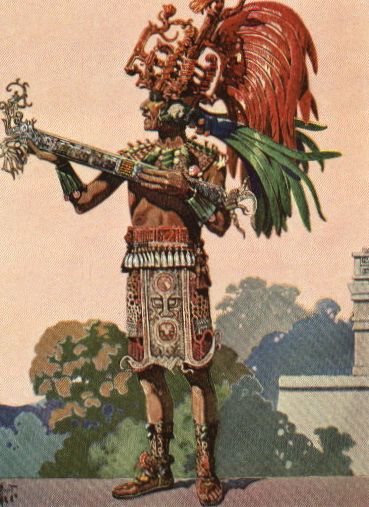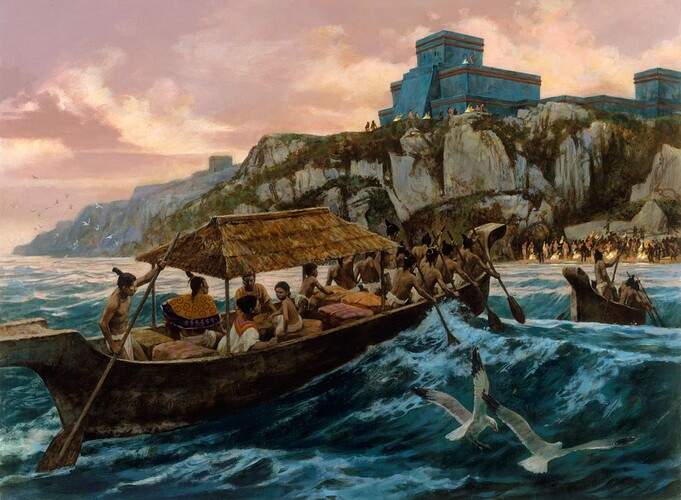**League of Mayapan **
The Maya Empire
Religion, Sacrefice, Infantry
Difficulty: 1/3
Bonuses
- Can transfer garrisoned units between Towncenters.
- Walls are 50% cheaper.
- Buildings cost 20% less.
- Villagers gather 14% slower, but drop off 15% additional resources.
- Religious buildings can Garrison up to 5 units.
- Unique Unit: Zabin (replaces Scout/Pathfinder)
- Unique Unit: Nacom Captain
- Unique Unit: Holkan (replaces Archers)
- Unique Unit: Hul’che (replaces Atlatl)
- Unique Unit: Nacom Priest
- Unique Building: Nunnery Quadrangle (replaces University)
Blood Offering**:** Mayans uses Offerings in order to age up, and in imperial age able to upgrade their Landmark into a Wonder. Mayans is able to collect offerings from killing enemie units and wildlife or sacrefice garrisoned units inside their temples. Garrisoned units inside templed gets turned into 1 Offering every 20 seconds.
Age up costs:
Feudal 24 offerings.
Castle: 55 offerings.
Imperial: 100 offerings.
Landmark Wonder: 2012 Offerings.
Unit Rooster:
- Age I: Zabin
- Age I: Spearman
- Age I: Nacom Captain(Unique)
- Age II: Holkan (Unique)
- Age II: Slinger
- Age III: Hul’che(Unique)
- Age III: Macuahuitl
- Age III: Nacom Priest/Priestess
- Age II: Siege Platform
- Age III: Siege Pyre (Platform Variant)
- Age II: Siege Tunneler (Platform Variant)
- Age II: Siege Tower (Platform Variant)
- Age III: Siege Mantlet (Platform Variant)
- Age I: Fishing Canoe
- Age II: Trade Canoe
- Age II: Light Canoe (Melee Ship)
- Age II: War Canoe (Archer ship)
- Age III: King Canoe (Attack Ship)
- Age III: Fire Canoe (Demoship)
Building Rooster:
- Age I: House
- Age I: Mining Camp
- Age I: Lumber Camp
- Age I: Farm
- Age I: Mill
- Age I: Outpost
- Age I: Palisade Gate
- Age I: Palisade Walls
- Age I: Siege Ladders
- Age II: Traps
- Age II: Docks
- Age II: Market
- Age II: Town Center
- Age II: Craftsman Hut
- Age II: Stone Wall Tower
- Age II: Stone Wall Gate
- Age II: Stone Wall
- Age III: Temple
- Age III: Keep
- Age IV: Nunnery Quadrangle
Technology Rooster:
Mill
- Age I: Water Preservation (Unique)
- Age I: Survival Techniques
- Age I: Wheelbarrow
- Age II: Horticulture
- Age III: Fertilization
- Age IV: Precision Cross-Breeding
Lumber Camp
- Age I: Forestry
- Age II: Double Broadaxe
- Age III: Lumber Preservation
- Age IV: Crosscut Saw
Mining Camp
- Age II: Specialized Pick
- Age III: Acid Destilization
- Age IV: Cupellation
Town Center
- Age II: Textiles
Barracks
- Age II: Blowgun
Tambo
- Age II: Arrow Slits
- Age II: Fortify Outpost
- Age III: Atlatl emplacement
- Age III: Tower Altar
- Age IV: Slinger Platforms
Craftsman hut:
- Age II: Siege Engineering
- Age II: Fitted Leatherwork
- Age II: Thick Woven Capes
- Age II: Obsidian Arrows
- Age II: Obsidian Edges
- Age III: Insulated Helm
- Age III: Quilted Cotton
- Age III: Balanced Projectiles
- Age III: Turtle dung glue
- Age III: Military Academy
- Age III: Chimelli Shields
- Age IV: Salt Brine Coating
- Age IV: Master Smiths
Archery Range
- Age III: K’iche Grenade (Unique)
Docks
- Age II: Extended Lines
- Age II: Additional Sails
- Age II: Additional Oars
- Age III: Drift Nets
- Age III: Armored Hulls
- Age III: Navigator Lookout
- Age IV: Flattened Hulls
- Age IV: Protective Canoe planking.
Temple
- Age I: Piety
- Age III: Herbal Medecine
- Age III: Blood Rites
- Age III: Ritual Sports
- Age IV: Tithe Barns
Keep
- Age III: Boiling Oil
- Age III: Javelin emplacements
- Age IV: Slinger Platforms
Nunnary Quadrangle:
- Age IV: Guirilla Traps
- AgeIV: Elite Army Tactics
- AgeIV: Incendiary Arrows
- AgeIV: Court Architects
- AgeIV: Siege Works
- AgeIV: Geometry
- Age IV: Nacom General (Unique)
- Age IV: Advanced Mathemathics
Temple of the Gods:
- Age I: Calendar
- Age IV: Doomsday prophecy
Observatory:
- Age II: Milpa
- Age III: Limestone Construction
- Age III: Star Charts
- Age IV: Monthly Rituals
Royal Palace:
- Age II: Holpop
- Age III: Nacom Ferocity
- Age IV: Batab
*Common
*Native American
*Civilization Unique
Unique Landmark:
-
Temple of the Gods:
Similar to the Abbasid House of wisdom.But is also able to produce unique units, Nacom Captain and Nacom Priests, and function as a Temple.
Feudal/Castle/Imperial:
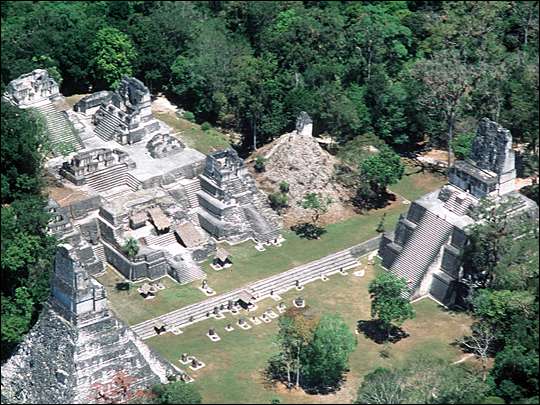
-
Observatory: Provides following unique Upgrades:
-Limestone Construction: Construction speed increased by 50%-Milpa: Increases gathering rate from farms by 10%-Star Charts: Increases movement speed of naval units by 20%-Monthly Rituals: Increases villagers production speed by 30% - Great Ballcourt: can activate 1 out of 5 ability granting resources at the cost of 20 Offerings.-Handball: Generates 100/150/200 Food every minute.-Stickball: Generates 100/150/200 Wood every minute.-Hipball: Generates 100/150/200 Gold every minute.-Kickball: Generates 100/150/200 Stone every minute.-Trickball: Generates 5/10/15 Offerings every minute.
- **Royal Palace:**Provides following unique Upgrades:
-Holpop: Every town center built, reduces cost of villagers by 10% up to a maximum of 50%.-Priestly Hiarchy: Reduces cost of Religious units by 50%-Batab: Doubles research speed, reduces cost of technology, units and buildings by 20% -
Festival Plaza: Has 3 abilities that provide global boon at the cost of 20 Offerings.
-Baldzamil: Doubles the rate of Offering gained from kills and sacrefice. Increases production speed on military buildings.
-Ezyah: All units takes reduced damage, loosing units near temple influence zone gains offerings.
-Okot: Gains offering over time at the cost of food and gold. Also doubles income of traders.
Wonder: Temple of the Gods with 2000 Offerings.
Unique Building:
-
Nunnery Quadrangle (Age IV, 300S):
Functions as a University with 100% faster research to any nearby buildings.
Unique Units:
-
Zabin (Age I, 75F):
Function as a special scout/pathfinder unit that is able to go into stealth. -
Nacom Captain (Age I, 200G):
A Religious Infantry unit that does bonus damage to infantry. Nacom Captain kills grant double the number of offerings. (Limited to the amount of Town centers one has. 1 Captain per Town Center.) -
Holkan (Age II, 40F 50W):
Archer unit with a fast movement speed. -
Hul’che (Age III: 80F 40G):

Specialized Spear thrower that throws an additional inaccurate attack alongside its main attack. Effective against crowds when used in a mass. -
Nacom Priest (Age III, 150G):
Nearby friendly unit deaths provide Offerings. Is able to use Buluc Chabtans blessing, granting a permanent +2 attack, at the cost of 1 Offering per friendly unit.
Unique: Technologies
- Calendar (Age I, 75F 75G): Increases gathering rates by 10%. Upgraded at Temple of the Gods.
- Water Preservation (Age I, 50S): Reduces the cost of farms by 20%. Upgraded at Mill.
- Milpa (Age II, 75F, 125G): Increases gathering rate from farms by 10%. Upgraded at Observatory.
- Holpop (Age II, 100F 50G): Every town center built, reduces cost of villagers by 10% up to a maximum of 50%. Upgraded at Royal Palace.
- Limestone Construction (Age III, 100F 150G) : Construction speed increased by 50%. Researched at Observatory.
- Star Charts (Age III, 150F 150G): Increases movement speed of naval units by 20%. Upgraded at Observatory.
- Nacom Ferocity (Age III, 250F 250G): Presence of the Nacom Captain reduces damage done by enemie infantry by 25%. Upgraded at Royal Palace.
- Ritual Sports (Age III, 300F 150G): Movement speed of all units increased by 10%. Upgraded at Temple.
- K’iche Grenade (Age III, 300F 250W): Slingers gain the ability to make a small area on the ground, enemie units standing ontop of it has their attack and defense by -25%, the effect lingers for 3 seconds. Upgraded at Archery Range.
- Monthly Rituals (Age IV, 400F 300G) : Increases villagers production speed by 30%. Upgraded at Observatory
- Batab (Age IV, 400F 300G): Doubles research speed, reduces the cost of technology, units, and buildings by 20% Upgraded at Royal Palace
- Advanced Mathemathics (Age IV, 300F 700G): Set up and Teardown of Siege Platform and its different modes is instant. Upgraded at Nunnery Quadrangle.
- Nacom General (Age IV, 300F 500G): Nacom Captain boosts melee and ranged armor to nearby units by +2. Upgraded at Nunnery Quadrangle
- Doomsday Prophecy(Age IV, 300F 700G): Requires Calendar to be researched. Halves the time it takes to cast conversion by Nacom Priests. Researched at Temple of the Gods.
Additional Notes:
Architecture: Maya architecture is quite famous, their ample supply of great building materials, such as Limestone, made them expert masons and created vast stone structures.
Mayan architects used a variety of methods to enhance the beauty of their buildings. Almost always they elevated temples and palaces by building them on top of pyramids, platforms, and acropolises. Great effort was made to ornately decorated the facades of their public buildings. Buildings were adorned with sculptures and huge stylized masks. In contrast, the insides of the buildings were very plain. Mayan homes were simple in construction. The walls were made of poles and plastered earth. The sharply pitched roof was made of thatched palm leaves supported by beans and saplings. Partitions divided the house into two sections. The rear half was a sleeping quarter and the front was used for everyday activities. Often the kitchens were kept separate. Floors were covered in leaves and were changed often. They also used fiber matting for floor coverings and bedding. Furniture was largely wooden stools and benches.
Naval units:
While not much is known from Maya maritime expeditions.
They were capable shipbuilders, although little remains of Mayan ships but a few well-preserved canoes.
It is speculated that they knew sailing, and there are clear traces of trade goods having been transported long distances from coastal regions and towns. As well as goods stemming from Native Carribeans.
There is also a theory that the Mayans may have been in contact with the Ancient Egyptians, as things such as Tobacco and other items common among Mayans has been found buried alongside the ancient Pharaos. But we don’t know if it was the Egyptians or the Mayans or perhaps both who manage to sail across. For now, its just a theory. A GAME THEORY.
Language progression:
The Mayan language can be classified as into 3 periods.
Proto-Mayan, Classical Period and Colonial Period.
While proto-mayan dates as far as 2000BC and the language itself branched into many sets of Dialects and their own semi-intelligable languages (similar to the Romance languages), they would most likely be speaking the Yucatecan lineage, as this is the most documented one and the precursor of the today spoken Yucatec.
Landmark references:
-
Temple of the Gods: The temple serves as the main structure of the Mayans, as the Mayans were never really one big empire, but rather a formation of many city-states, their influence often reflected by the size of their temples. The more populace and thriving the city-state was, the bigger the temple had to be to accommodate the population.
The Mayan Temples were constructed progressively, meaning they would start out smaller in size, built on top of a hill, and over time the temple would be built over itself, increasing in size over time.
Close to the central temple would also be buildings of importance in the Mayan city-states, such as the Palace of the royalties and nobilities, an observatory as astronomy was very important in Mayan religion, a plaza where festivals and other important rituals were held, such as the Baldzamil, a theatre like performance; Ezyah, an Illusionist, often referred to as magician would perform acts of miracles; and the Okot, a great feast, and festival where performers would dress up in costumes and perform a ritualistic dance to celebrate important monthly events. Such as Fertility, Harvest, the Coronation of a New King and etc. And then of course we cannot forget the Great Ballcourt, every Maya city-state had one. Ballgames were hugely important in Mayan culture, it did not only serve as a form of entertainment but also a place to climb the social rankings, a place of religious ceremony and quite often, a place where gambling where prone much like today’s sports.
But unlike today’s sports. Some games pitched the Spectators against the Teams, where the winning Team would be allowed to take all the spectator’s belongings that they brought with them. Which made the peculiar result of many spectators showing up naked or only a thin piece of clothing.
Unique Unit:
Zabin:
- Health: 105
- Attack: 4 Melee (Spear); 4 (Blowgun); +10 vs scout, + 12 vs wildlife.
- Rate of Fire: 2s (Spear); 1s (Blowgun);
- Range: 3 tiles (Blowgun)
- Armor: 0
- Pierce Armor: 0
- Speed: 1.38 tiles/s
Note: Zabin functions as a professional scout and can carry deer carcasses, also able to herd sheep. Blowgun attack does poison attack, 1 Damage every second for 4 seconds.
Zabin also has a stealth Ability, is unable to attack when in stealth, and movement speed is halved.
When entering combat the stealth is removed and a 2-minute cooldown starts.
Nacom Captain:
- Health: 100/135/270/400
- Attack: 8/10/12/14 Melee (Macuahuitl); +3/5/7/9 vs Infantry
- Rate of Fire: 1.25 (Macuahuitl)
- Armor: 0/1/2/3/4
- Pierce Armor: 0/1/2/3/4
- Speed: 1.38
Note: gain double the amount of Offering from kills. Can be upgraded with Nacom Ferocity (Passive); which causes nearby infantry units to deal 25% less damage. And Nacom General (Passive) which grants all nearby units +2 melee and ranged armor.
Holkan:
- Health: 70/80/95
- Attack: 6/8/9 (Bow); +6/7/8 vs Light Melee infantry.
- Rate of Fire: 1.5s (Bow);
- Range: 5 tiles
- Armor: 0
- Pierce Armor: 0
- Speed: 1.5 tiles/s
Note : A high mobility archer unit.
Hul’Che:
- Attack: 12/15 (Atlatl); +9/11 vs Heavy
- Rate of Fire: 1.5s
- Range: 4 tiles (Atlatl)
- Armor: 0
- Pierce Armor: 0
- Speed: 1.12 tiles/s
Note : Slowest of all Mayan units, is strong against armored targets, fires 2 projectiles at the same time, where the second projectile is inaccurate, making them very efficient when dealing with masses.
Nacom Priest/Priestess:
- Health: 90
- Attack: 0
- Rate of Fire: 0
- Armor: 0
- Pierce Armor: 0
- Speed: 1.13
Note: A Religious unit that is able to provide offerings from nearby friendly unit deaths, is also able to use Offering resources in order to provide a permanent +2 attack on a friendly unit.
Write-up: Mayans, there is so much to say about the Mayans.
The Mayans are an incredibly interesting group of people. While they never really made an “empire” in itself. They were a group of people with tight cultural connections and identities. And mostly formed a collection of city-states with 20km distance between each other.
Why 20km? Well due to the logistic of warfare, and the lack of navigable interconnecting rivers and pack animals, 20km was about the limit human porters carrying supplies for their armies was able to traverse the Yucatan. Now it certainly didn’t stop them from campaigning against each other, which happened more than frequently, it formed mostly as a deterrent, forcing an enemy city-state to raise a considerable large army first, before making it worth the effort of campaigning against their neighbors.
Mayans were among the first civilizations in Mesoamericans and were among the last to fall. Even today there still exist a handful of Mayan people who keeps their cultural heritage loosely intact, although very limited due to the modern age we live in today.
Mayans were masters of many things. Science, Agriculture, and Constructions. Their legacy is still firmly and quite literally set in stone up to the present day and most likely far into the future. Many great Mayan temples are cleverly hidden by nature, deep inside the Yucatan jungle.
One such example is the El Mirador and the La Danta pyramid, comparable to the size of the great Egyptian pyramid of Giza.
And all this was also thanks to great Mayan warriors, while the Aztecs Warriors are more famous than their Mayan counterparts. There is good reasons why the Aztecs never really expanded into Mayan territories, besides being abruptly ended by the Spaniards.
The Mayans would employ guerilla tactics, preferably to drag the enemies deep into the jungle, laden with clever traps, and weaken them with their ranged weaponry. The Yucatan jungle is also quite a hazardous place to go through if you don’t have good knowledge of the area. Filled with unexpected sinkholes and formidable Jungle terrain that can quickly get you entangled and stuck.
But the Mayans were also quite clever in diplomacy and used this to their full advantage. It was one of the reasons why despite the fact that Mayans were the first Mesoamericans the Spaniards encountered, they didn’t focus on campaigning into Mayan territory until much later when pretty much the Aztec and Inca empires were already conquered.
And by that time, or to be more exact, by the time the Spaniards encountered the Mayans, they were merely a shadow of their former glory. Because the worst enemies of the Mayans were the Mayans themselves. The Mayans have expanded and collapsed several times over their more than a Millenia of years of existence. This could be due to one of many reasons, It could be because, and quite often, the rivalry between Mayan city-states. But it was also due to environmental reasons, due to the pressure of the high populace required from the lands around them. The Yucatan isn’t exactly the best place to start up a civilization, some professors going as far as comparing it to a Civilization trying to start out in the Antarctic or in the middle of the desert.
The land was mostly on top of Limestone formations, which had the negative effect of being very vulnerable to drought. The more the Mayans cut into the jungle, the more severe droughts they would experience in return. The Mayans developed effective means of Water conservation, but it could only do so much. This resulted in the Mayans suffering from food shortages to feed an ever-increasing population, which eventually lead to the abandonment of great cities, and migration to neighboring city-states, causing them to grow rapidly in strength and influence, but also hastening their shared faith to any Mayan city that happens to grow to large for the land to sustain it.
But then again, this was pretty normal for Mayan culture, their religion is based on a Cyclical calendar. The world ends and begins a new for each cycle.
And this just barely scratches the surface of the Mayans.
When it comes to the Game itself; I wanted the Mayans to be different in the way they age up, I want them to thematically play with their Religion, where sacrifice plays a very important role.
I also always wanted to play on the Abbasid single-landmark house of wisdom. But Different, and giving them a Winning condition that once a required number of Offering is met, their landmark becomes a Wonder, and starts the countdown.
Playing aggressively, and using the Landmark global buffs becomes a key to playing the Mayans.
The Mayans, along with the Incas, are also able to produce Traps, to help lure and weaken their opponent.
And their Zabin (Lit translation: Road Weasels) becomes instrumental in gathering intelligence. Allowing you to plan your next move. Much like how the Mayan city-states were notorious for plotting against each other.
Next up: Aztec or Incas. IDK. You choose.
AoE4 Civ Concept: Aztecs
AoE4 Civ Concept: Inca
For more information about common native american units and tech:
AoE4 Civ Concept: Native American BASIS.
